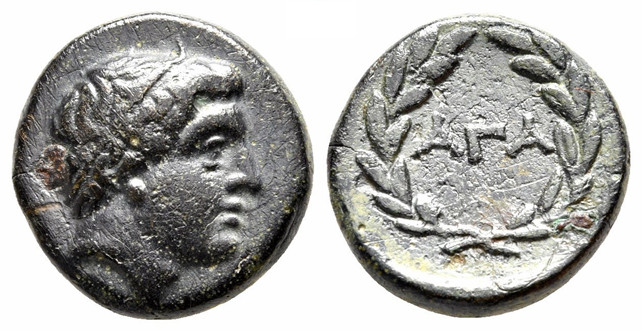| 350
- 250
BC |
Αγαθόπολις Θρακική Χερσόνησος
| AE 16 |
SHH 7083 |
 |
| Parameter Obverse Reverse Notes Reference Provenance |
4.53 g 15.4-16.2 mm 2.6 eqmm
6:00
o'clock VF centering - / - σmax(SigmaTest, 240 Hz) = obv. 4.6, rev. 5.0 MS/m Diademed male head (Agathocles ?) right. ΑΓA within laurel wreath. Similar coins with the intitials A, AΓ or AΓA and a laurel wreath have been attributed to different mints: 1, Agathopolis Penisula Thraciae. See Agathopolis SHH 6145 , SHH 325 [SNG Austria, Sammlung Dreer] 2. Maroneia Thracia named temporariliy Agathocleia. See Maroneia Thracia SHH 6145, SHH 6771, SHH 5513, 6627 Selene Psoma (2008, p. 213-215) attributes this coin to a military issue of Agathocles, son of Lysimachus, during his reign over the city of Maroneia, where 9 specimens of this type were found during excavations. It is also suggested that the city was named Agathocleia during this period, and renamed Maroneia after the death of Agathocles 282 BC. [Psoma (2008)] 3. Adramytium Mysia, issue of Agathocles son of Lysimachus (this coin) Tekin has recently reattributed the coins of 'Agathokleia' to Agathokles, the oldest son of Lysimachos, who was his father's right-hand man in the late 290s and 280s BC. However, Lysimachos' second wife Arsinoe intrigued against him and he was executed in 283/2 BC on charges of conspiracy against the old king. Agathokles' wife Lysandra, a daughter of Ptolemy I, escaped the trial and fled to Seleukos, who marched against Lysimachos and killed him in the Battle of Korupedion in 281 BC - the decisive battle between the last surviving generals of Alexander. [Tekin (2013)] Tekin (2013) series 2 Ex Savoca Blue 30/217 |